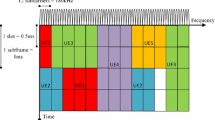Abstract
Facing the challenges brought by the surge in the demand for mobile data traffic, many coexistence algorithms for long-term evolution (LTE) and WiFi networks in the unlicensed spectrum have been developed recently. In this article, we investigate, optimize, and compare several solutions to operate LTE in the unlicensed band, which include duty-cycle muting (DCM) mechanism, listen-before-talk (LBT) mechanism, and LTE and WLAN aggregation (LWA) algorithm. We first overview the architecture, working mechanism, coexistence problem with WiFi network, and overall cost of the three different coexistence mechanisms. Their advantages and disadvantages are also compared and analyzed in detail. Then, to maximize the spectrum efficiency of unlicensed band, we optimize the corresponding adjustable variables in the three algorithms. Furthermore, numerical simulations are conducted to compare the performances of DCM, LBT, and LWA explicitly. The results show that DCM can achieve the highest throughput for the LTE network while LBT and LWA have less impact on the WiFi system.








Similar content being viewed by others
References
Yin, R., Yu, G., Maaref, A., & Li, G. Y. (2016). A framework for co-channel interference and collision probability tradeoff in LTE licensed-assisted access (LAA) networks. IEEE Transactions on Wireless Communications, 15(9), 6078–6090.
Liu, R., Chen, Q., Tang, Z., & Yu, G. (2018). Joint user association and resource optimization for unlicensed LTE systems. In IEEE international conference on communications, Kansas City, USA.
Shoaei, A. D., Derakhshani, M., & Le-Ngoc, T. (2018). Efficient LTE/WiFi coexistence in unlicensed spectrum using virtual network entity: Optimization and performance analysis. IEEE Transactions on Communications, 66(6), 2617–2629.
Mushunuri, V., Panigrahi, B., Rath, H. K., & Simha, A. (2017). Fair and efficient listen before talk (LBT) technique for LTE licensed assisted access (LAA) networks. In IEEE international conference on advanced information networking and applications, Taiwan, China.
Elsherif, A. R., Chen, W. P., Ito, A., & Ding, Z. (2015). Resource allocation and inter-cell interference management for dual-access small cells. IEEE Journal on Selected Areas in Communications, 33(6), 1082–1096.
Liu, F., Bala, E., Erkip, E., Beluri, M. C., & Yang, R. (2015). Small-cell traffic balancing over licensed and unlicensed bands. IEEE Transactions on Vehicular Technology, 64(12), 5850–5865.
Ying, X., Poovendran, R., & Roy, S. (2017). Detecting LTE-U duty cycling misbehavior for fair sharing with WiFi in shared bands. In IEEE 28th annual international symposium on personal, indoor and mobile radio communications, pp. 1–7, Quebec, Canada.
3GPP. (2016). Analysis of LTE WiFi aggregation solutions. http://www.3gpp.org/news-events/3gpp-news/1789-laa update. Retrieved from 1, Oct 2018.
Qualcomm. (2015). LTE-U technology and coexistence, LTE-U forum workshop. http://www.lteuforum.org/workshop.html. Retrieved from 1, Oct 2018.
WiFi alliance. (2015). Coexistence guidelines for LTE in unlicensed spectrum studies. https://www.wi-fi.org/.
Rupasinghe, N., & Guvenc, I. (2015). Reinforcement learning for licensed assisted access of LTE in the unlicensed spectrum. In Proceedings of IEEE wireless communications and networking conference, pp. 1279–1284, New Orleans, USA.
Choi, S., & Park, S. (2015). Coexistence analysis of duty cycle method with WiFi in unlicensed bands. International Conference on Information and Communication Technology, pp. 894–897, Jeju, South Korea.
Ko, H., Lee, J., & Pack, S. (2016). A fair listen-before-talk algorithm for coexistence of LTE-U and WLAN. IEEE Transactions on Vehicular Technology, 65(12), 10116–10120.
Yin, R., Yu, G., Maaref, A., & Li, G. (2016). LBT-based adaptive channel access for LTE-U systems. IEEE Transactions on Wireless Communications, 15(10), 6585–6598.
Chen, Q., Yu, G., & Ding, Z. (2016). Optimizing unlicensed spectrum sharing for LTE-U and WiFi network coexistence. IEEE Journal on Selected Areas in Communications, 34(10), 2562–2574.
Chen, Q., Yu, G., Elmaghraby, H. M., Hamalainen, J., & Ding, Z. (2017). Embedding LTE-U within Wi-Fi bands for spectrum efficiency improvement. IEEE Network Magazine, 31(2), 72–79.
Wang, Y., Yu, G., Yin, R., Jin, X., & Cen, S. (2019) A distributed network selection method based on minority game for LTE in unlicensed bands. In IEEE ICC 2019.
Bianchi, G. (2000). Performance analysis of IEEE 802.11 distributed coordination function. IEEE Journal on Selected Areas in Communications, 18(3), 535–547.
Author information
Authors and Affiliations
Corresponding author
Additional information
Publisher's Note
Springer Nature remains neutral with regard to jurisdictional claims in published maps and institutional affiliations.
Rights and permissions
About this article
Cite this article
Zhang, J., Liu, S., Yin, R. et al. Coexistence algorithms for LTE and WiFi networks in unlicensed spectrum: performance optimization and comparison. Wireless Netw 27, 1875–1885 (2021). https://doi.org/10.1007/s11276-020-02540-8
Accepted:
Published:
Issue Date:
DOI: https://doi.org/10.1007/s11276-020-02540-8




